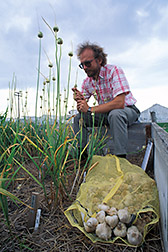|
|
Growing Garlic From True Seed
Increased genetic variability is the goal.
Used as a spice, an herb, and as a vegetable, garlic is one of the oldest known cultivated crops in history.
A member of the Lily family, Alium sativum is normally sexually sterile. It produces a pungent bulb that resembles an onion in size, but its leaves have solid, flat blades rather than hollow, tubular ones.
"Garlic plants that produce flowers are rare in most U.S. varieties. By cutting the flower stalk from the underground bulb, we were able to stimulate seed production in certain garlic strains," says Philipp W. Simon, plant geneticist at the ARS Vegetable Crops Research Laboratory in Madison, Wisconsin.
He used 200 clones, including standard U.S. varieties of A. sativum, and a wild ancestor, A. longicuspis, from ARS' Plant Germplasm Introduction and Testing Research Unit in Pullman, Washington.
Sixty percent of these clones, from germplasm originating in Brazil, Germany, Poland, and the former Soviet Union, produced flowers.
Botanical seed derived from the garlic flowers—true seed—resembles little, black onion seeds. "True seed shouldn't be confused with seed garlic—a term that refers to cloves or bulbs typically used to plant a garlic crop," says Simon.
In California, the two major garlic types that produce large cloves and high yields are known as early- and late-maturing varieties. One key trait growers would like to alter is the time it takes for garlics to mature. In California, the growing season is about 10 months long beginning in the fall, with planting from late September through November.
California growers produce about 250 million pounds of garlic on 21,000 acres. About 50 million pounds are sold on the fresh market, and 200 million pounds are dehydrated for use as flakes, salt, and in packaged foods, according to a spokesperson for the Christopher Ranch near Gilroy, California.
The capacity to develop garlic from true seed is an important research tool for increasing genetic variation of the crop. Once tapped, this variability could lead to garlics of different types, higher yields, and disease resistance.
"One ideal scenario," says Simon, "would be to develop an earlier maturing variety."
Simon says that by combining genetic traits of different garlic plants it may someday be possible to produce garlics with sweeter and less pungent flavors—an idea that many garlic lovers might relish. — By Linda Cooke, ARS.
Philipp W. Simon is at the USDA-ARS Vegetable Crops Research Laboratory, 1575 Linden Drive, University of Wisconsin, Madison, WI 53706; phone (608) 262-1248, fax (608) 262-4743.
|
Often-Requested Germplasm Garlic accounts for only 190 of the 30,000 samples of horticultural crops--onion relatives, beans, legumes, lettuces, and beets--stored at the Western Regional Plant Introduction Station in Pullman, Washington. But it's one of the most-often- requested crops. With marble- to baseball-sized bulbs, strong-flavored Polish varieties, and red and purple bulbs, the collection reflects the genetic diversity of this historically popular plant. The station's garlic collection has grown from just 13 accessions in 1983. Small farmers request sample garlic bulbs to start new crops, while commercial growers use the bulbs to select desired traits. Curator Richard M. Hannan's goal is to maintain the integrity of each sample in the collection. To keep them long-term, he's studying ways to preserve the different garlics in tissue culture and liquid nitrogen. — Kathryn Barry Stelljes, ARS. |
"Growing Garlic From True Seed" was published in the February 1995 issue of Agricultural Research magazine.







